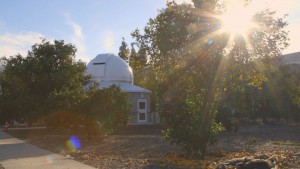CSUN Solar Observatory Celebrates Move to New Home

CSUN’s solar observatory has returned to the campus. Photo by Richard Chambers
It is one of only a dozen solar observatories in the country and one of the oldest still in use. On March 15, the San Fernando Observatory will celebrate its new home on California State University, Northridge’s main campus.
The observatory’s dedication ceremony is scheduled from 3 to 5 p.m. on Tuesday, March 15, in the Orange Grove, located on the southeast side of campus at 18111 Nordhoff St., Northridge.
CSUN physics and astronomy department chair Say-Peng Lim said the observatory has provided enormous opportunities for students and professors to study the sun over the years.
“The sun is not only the provider of energy for Earth,” he said. “It is also responsible for the weather — it provides us with sunlight, with warmth. These are things that everyone knows. But what is not clear to everyone is that the sun is actually not a smooth ball of fire. It is actually a very violent and turbulent ball of hot plasma.”
Solar astronomer, CSUN professor emeritus, director and donor to the observatory Gary Chapman has been with the observatory since its conception in the late 1960s, when it was gifted to the university by the Aerospace Corporation and placed on the Metropolitan Water District’s property in the northern San Fernando Valley.
Since then, Chapman’s research has helped NASA better predict the cause of long term variation of radiation from the sun and when dangerous bursts of energy, called solar flares, might reach near Earth’s orbit or atmosphere.
The observatory’s move to CSUN’s main campus will provide more opportunities for students to conduct practical solar research and use skills they learned in a classroom setting on a real-life application, Chapman said.
“By being on campus, we are going to be more visible,” he explained. “People will see the dome. Students can walk from their classroom to the campus observatory and help us collect data. By having a research project, you break down barriers of [lessons] from this class or another and make a project.”
Former physics and astronomy department chair and observatory donor John Lawrence agreed that having the observatory on campus will make research more accessible.
“If it’s right here on campus, it’s very convenient,” he said. “I think there will be more student involvement in actual projects analyzing data.”
Wendy Garen, CEO and president of The Ralph M. Parsons Foundation, said the observatory’s hands-on applications will be more available with the move.
“This little observatory has the longest record [helping perform solar research] of any Earth-based observatory,” she said. “It’s important science. But even more important than it being science — it’s an observatory that provides research opportunities for students.”

 experience
experience